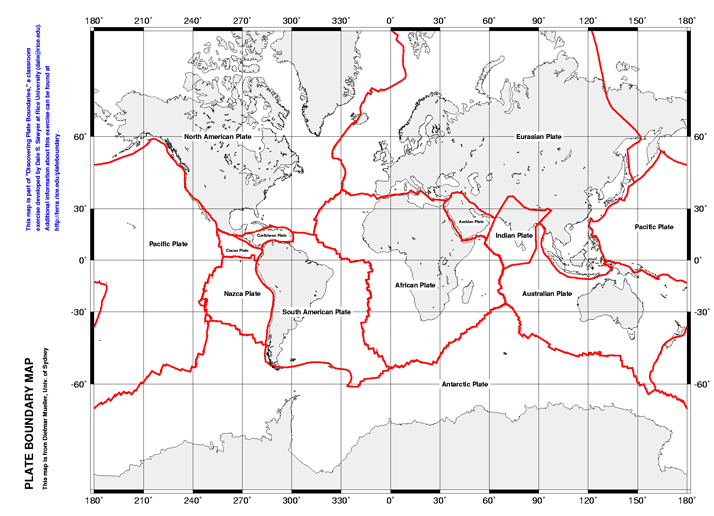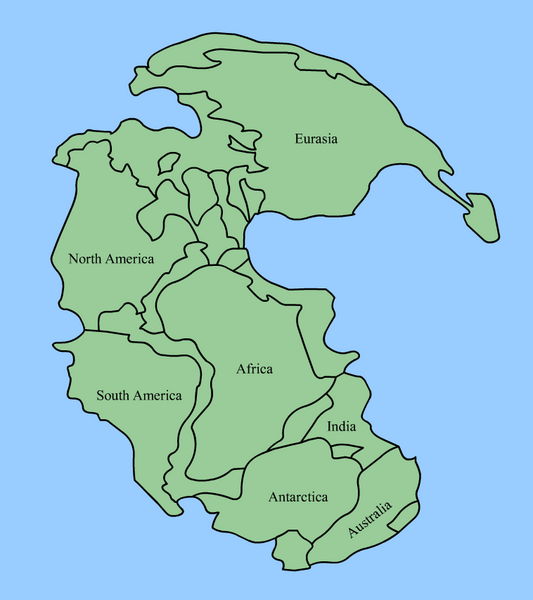Introduction to Plate Tectonics
This lesson begins with an introduction to some fundamental geology. Perhaps you've heard of the paradigm known as plate tectonics. Plate tectonics states that the outer ~100 km of the Earth - known as the lithosphere - is composed of rigid sections of ocean and continental crust and the rigid upper mantle. These lithospheric sections "float" and move on a weaker, plastic or fluid part of the mantle known as the asthenosphere. The edges of these lithospheric plates are where we witness most of Earth's tectonic activity, such as volcanism and earthquakes. In fact, plate boundaries are defined by the occurrence of volcanic eruptions and seismic activity.
Check out this map that diagrams the location of plate boundaries, and below it is a map of the locations of Earth's major earthquakes—there's a reason these two look the same!

Location of the Earth's major plate boundaries. Source: Discovering Plate Boundaries.
Note: Please click on the image to see a larger version.

Location of the Earth's major earthquakes. Source: Discovering Plate Boundaries.
Note: Please click on the image to see a larger version.
One of three types of motion can occur at the plate boundaries. The boundary may be divergent, where two plates move away from one another. This motion is caused by molten material rising from the asthenosphere and pushing the plates apart. In time, the magma solidifies and forms new ocean floor. In this process, large continents (such as Pangaea, shown below) break apart to form smaller continents plus oceans.

Graphic representation of Pangaea, showing continents. Source: Wikipedia
Now as you know, the Earth certainly isn't growing any bigger! Since we generate new crust at the divergent boundaries, we must lose crust someplace on the earth. These locations where we recycle crustal material are known as convergent boundaries. Convergence of plates can cause different types of results. If a lithospheric plate with oceanic crust encounters another segment of oceanic crust, one of the plates (usually the older, because ocean floor becomes denser over time) will be forced below the other, causing ocean crust to be recycled back into the mantle. This process is known as subduction. If oceanic crust is pushed towards continental crust, the oceanic plate will be subducted; since oceanic crust is denser than continental, it will be pushed beneath the continental material. If ocean crust forms the leading edge of a plate that has continental material as well, eventually all of the ocean floor will be gone (subducted). When that happens, the two segments of continental crust collide, pushing each other up away from the mantle and creating a land-based mountain chain.
So we've discussed two types of movement that can occur at plate boundaries - divergence and convergence. There is a third type of movement that is just as important and just as destructive. There may be the situation where one tectonic plate slides past another, neither creating nor destroying crust. This is called a transform plate boundary. You are probably familiar with a very famous transform plate boundary, the San Andreas Fault that lies between the North American Plate and Pacific Plate.
As long as the earth has been differentiated into a crust, mantle and core, plate tectonics has been occurring, shaping the ocean basins and landforms that we see today. Be sure to study all the images on this page carefully, because we'll be returning to the concepts shown later in this lesson.